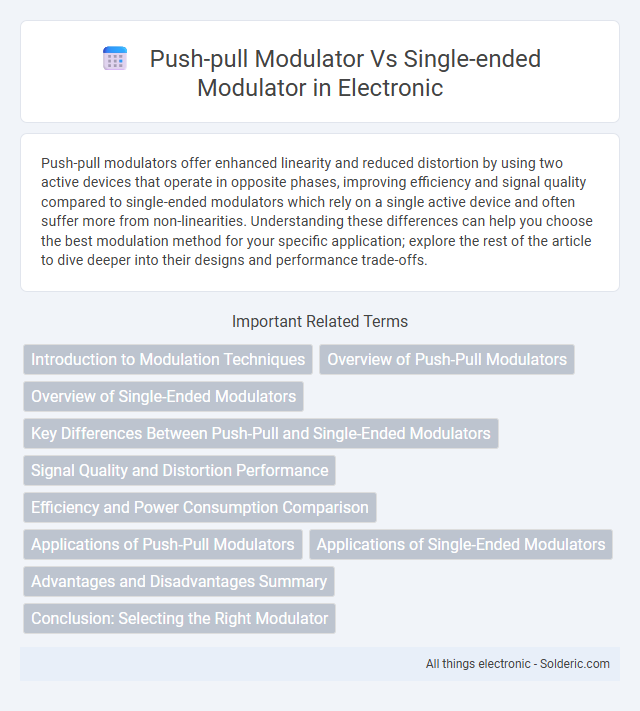Push-pull modulators offer enhanced linearity and reduced distortion by using two active devices that operate in opposite phases, improving efficiency and signal quality compared to single-ended modulators which rely on a single active device and often suffer more from non-linearities. Understanding these differences can help you choose the best modulation method for your specific application; explore the rest of the article to dive deeper into their designs and performance trade-offs.
Comparison Table
| Feature | Push-Pull Modulator | Single-Ended Modulator |
|---|---|---|
| Configuration | Two active devices operating in opposite phases | Single active device |
| Linearity | Higher linearity due to differential operation | Lower linearity, more distortion prone |
| Output Power | Typically higher, balanced output | Lower output power |
| Even-Order Harmonics | Reduced even-order harmonic distortion | Higher even-order harmonic distortion |
| Complexity | More complex circuit design | Simpler design and implementation |
| Efficiency | Generally higher efficiency | Lower efficiency |
| Common Applications | High-performance RF transmitters, analog signal modulation | Low-cost, low-power modulation scenarios |
Introduction to Modulation Techniques
Push-pull modulators use two active devices operating in opposite phases to improve linearity and reduce distortion compared to single-ended modulators, which rely on a single active device. Single-ended modulation techniques are simpler but often suffer from higher even-order harmonics and limited efficiency. Push-pull designs are widely favored in power amplification stages for their enhanced performance in high-fidelity and high-power applications.
Overview of Push-Pull Modulators
Push-pull modulators utilize two active devices operating in opposite phases to drive a load, significantly reducing even-order harmonic distortion and improving linearity compared to single-ended modulators. This configuration enhances efficiency and signal integrity, making push-pull modulators ideal for high-performance RF and audio applications. Your system can benefit from their balanced design by achieving lower distortion and better power handling.
Overview of Single-Ended Modulators
Single-ended modulators use a single transistor or device to generate amplitude or phase modulation, making them simpler and more cost-effective for low-power applications. Their design results in easier implementation but often suffers from lower efficiency and higher distortion compared to push-pull modulators. Your choice of a single-ended modulator suits scenarios with limited complexity and moderate performance requirements.
Key Differences Between Push-Pull and Single-Ended Modulators
Push-pull modulators utilize two transistors or devices driven out of phase to reduce even-order harmonics and improve linearity, while single-ended modulators operate with one active device, leading to simpler design but higher distortion. Push-pull configurations provide better power efficiency and increased output power capability compared to single-ended modulators. However, single-ended modulators offer easier integration and lower circuit complexity, making them suitable for low-power or less performance-critical applications.
Signal Quality and Distortion Performance
Push-pull modulators deliver superior signal quality by effectively canceling even-order harmonics, resulting in lower distortion and enhanced linearity compared to single-ended modulators. Single-ended modulators often exhibit higher distortion levels due to their asymmetric operation, which can negatively impact signal clarity and fidelity. Choosing a push-pull modulator can significantly improve your system's performance by minimizing harmonic distortion and maintaining signal integrity.
Efficiency and Power Consumption Comparison
Push-pull modulators offer higher efficiency compared to single-ended modulators by effectively canceling even-order harmonics and reducing power loss. This design enables lower power consumption and improved thermal management, making push-pull configurations preferable for applications demanding energy efficiency. Your choice of modulator directly impacts overall system performance and operational costs due to these efficiency differences.
Applications of Push-Pull Modulators
Push-pull modulators are widely used in radar transmitters, high-power RF amplifiers, and optical communication systems due to their superior linearity and reduced even-order harmonic distortions compared to single-ended modulators. Their ability to efficiently cancel out noise and distortion makes them ideal for applications requiring high signal integrity and power efficiency. You can achieve better performance in precision signal modulation tasks by selecting push-pull modulators over single-ended types.
Applications of Single-Ended Modulators
Single-ended modulators are widely used in applications requiring simple, low-cost modulation circuits such as in short-range communication systems, basic signal processing, and low-power RF transmitters. Their compact design and ease of implementation make them ideal for portable devices and low-frequency analog modulation tasks. Understanding your specific application requirements can help determine if a single-ended modulator provides sufficient performance and efficiency compared to more complex push-pull designs.
Advantages and Disadvantages Summary
Push-pull modulators offer improved linearity and reduced even-order harmonics compared to single-ended modulators, resulting in better signal fidelity and lower distortion in communication systems. Single-ended modulators are simpler in design and require fewer components, making them cost-effective and easier to implement but suffer from higher distortion and lower efficiency. Push-pull designs consume more power and demand precise component matching, which can increase complexity and manufacturing costs.
Conclusion: Selecting the Right Modulator
Push-pull modulators offer superior linearity and reduced distortion, making them ideal for high-power and high-frequency applications. Single-ended modulators are simpler, more cost-effective, and suitable for low to moderate power systems where design complexity and component count are critical. Choosing the right modulator depends on application requirements such as power handling, signal integrity, cost constraints, and overall system complexity.
Push-pull modulator vs single-ended modulator Infographic

 solderic.com
solderic.com